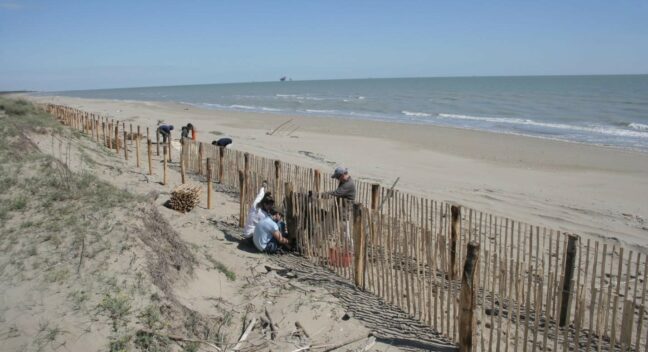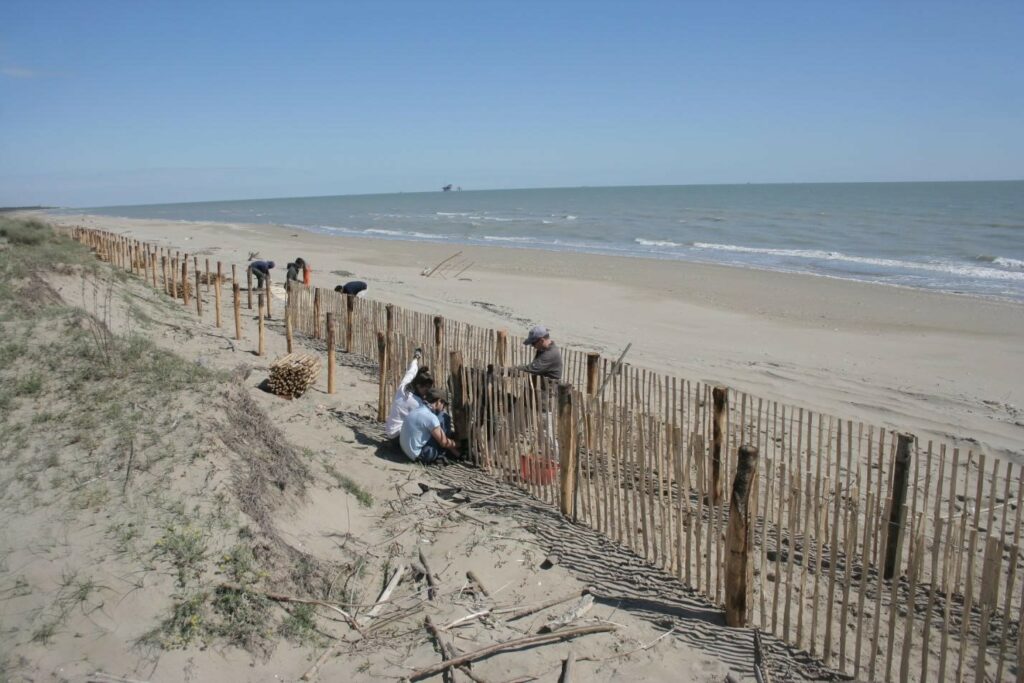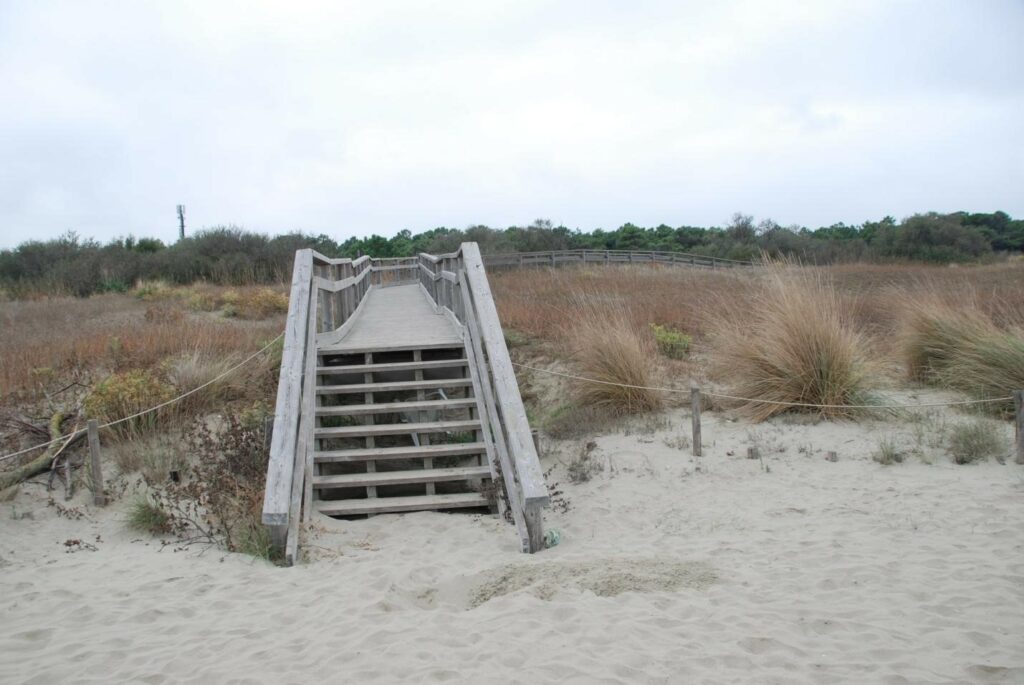Dune construction and strengthening

Description
Dune erosion results from wind and wave action. It is a natural phenomenon that can be worsened by human activities such as dune levelling to build urban settlements, parking-lots, promenades, etc. This contributes to the deficit of beach sediment needed to overcome periods of intense storms. In addition, eliminating dune vegetation or creating access to the beach with orthogonal direction can have the same effect. Dune construction and restoration are among the most important techniques of fighting coastal erosion and sea-level rise impacts along sandy beaches, and preserving the dunes function, not only as sand reservoirs, but also as important ecosystems.
Dune construction encompasses engineering artificial dunes through reproducing the form of natural dunes, often in a chain-like manner. Dunes are built with sand usually brought from an external source area and shaped into dunes using bulldozers, often carried out at the same time as beach nourishment. In many cases geotextiles are used as a core since they don’t need heavy machinery or heavy transport. Synthetic nets with gravel and pebbles can be used as well.

Dune strengthening includes the following processes:
- Dune grass planting on the face of the dune, to trap and hold sand to help stabilise dunes and protect them from damage by storms. The number of plant varieties that can be planted on dunes is fairly small: the selected species must be resistant to silting up, wind and salinity. Regular monitoring and, when needed, re-planting will be necessary. Sometimes, some additional works need to be carried out, such as the installation of wind screens to prevent wind erosion and roots unearthing.
- Dune thatching: covering the face of the dune with plant debris and branches to stabilise sand, encourage sand accretion, and protect dune vegetation. Materials used for thatching can be biodegradable and favour the development of plants and grass. Such materials can be put on the ground manually or mechanically (thatching must often be limited since transport by machines can lead to deterioration). Dune thatching needs regular maintenance.
- Dune fencing along the seaward face of the dune to encourage foredune deposition of transported sediment, and act as barriers that mitigate wind and wave impacts. Fences are often constructed of wood, but also other material (e.g. modified used fish netting). Dune fencing can increase the deposit of organic matter and result in the growth of grasses and other plants. This technique will be difficult on steep slopes and in instable areas, with maintenance being complex in crowded touristic areas.
Dune strengthening methods are often inter-combined: grass planting usually requires fencing and thatching to succeed. Dune strengthening techniques, in general, do not damage the dune, they can limit the access to the beach, though in many cases walkways and confined paths can bypass these areas. Such walkways (often wooden) are accepted by beach goers since they seem to prefer to walk on them rather than on sand, and in general they ease the access to the beach.

Costs and benefits
Dune strengthening and construction techniques can combine coastal defence with other benefits, such as habitat and biodiversity preservation and eco-tourism. Interventions on dunes are more effective when they are integrated with the restoration or construction of the complete coastal belt.
Dune strengthening techniques are low-cost solutions to reduce dune erosion, assuming the land use of particular area is not an obstacle. However, these techniques have limited success if erosion is quite severe. They can also be labour intensive. They have a limited lifetime and require frequent maintenance (replacing plants, putting fertiliser, replacing branches blown away, repair after vandalism, etc.). Maintenance costs could therefore exceed the initial costs of rehabilitation measures over the years.
Dune construction costs can be of similar range as beach nourishment costs. Maintenance costs should also be foreseen, such as regular grass planting or fencing. Constructed dunes can restore the recreational value of the beach and provide valuable habitats for animal and plant species. Also, hybrid combinations of a dyke-core in a dune may provide high safety in combination with a more appealing landscape.
In a recent work by Fernández-Montblanc et al. (2020) a simple economic assessment based on previous experiences in the Emilia Romagna region for nourishment and dune reconstruction has been performed. The study mentions that recent cost estimations (Table 1) for dune rehabilitation (reconstruction and revegetation) in the regional coastal domain ranged from € 30,000 to 250,000 per 100 m of dune length, yet remain highly uncertain.
Table 1. List of services from previous dune reconstruction/re-vegetation experiences in the Emilia-Romagna region (Fernández-Montblanc et al., 2020)

In the RISC-KIT project a cost of increase of height and width of the Praia de Faro dune (Portugal), as part of the dune rehabilitation, was estimated at about 62 to 74 €/m3. When compared to other measures achieving similar effects, it was assumed that a conservative 40 year lifetime of this dune rehabilitation measure results in a cost effectiveness value of approximately 1.50 to 1.85 €/m3/year.
Implementation time and lifetime
Implementation time: 1-5 years; Lifetime: 5-25 years, in some cases even more than 40 years
Source for more detailed information
https://climate-adapt.eea.europa.eu/metadata/adaptation-options/dune-construction-and-strengthening
https://www.coastal-management.eu/measure/dune-strengthening-rehabilitation-and-restoration
Fernández-Montblanc, T., Duo, E., and Ciavola, P. (2020) Dune reconstruction and revegetation as a potential measure to decrease coastal erosion and flooding under extreme storm conditions, Ocean & Coastal Management, https://doi.org/10.1016/j.ocecoaman.2019.105075
Linham, M.M. and Nicholls, R.J. (2010) Technologies for climate change adaptation: coastal erosion and flooding (TNA Guidebook Series) New Delhi, IN.
PAP/RAC (2021) Handbook on coastal resilience for the Adriatic, INTERREG AdriAdapt project, Split.
UNEP (2016) Options for Ecosystem-based Adaptation (EBA) in Coastal Environments: A Guide for environmental managers and planners. UNEP, Nairobi
We kindly thank Prof. Enzo Pranzini from University of Florence, for all the help and support in preparation of this text.
